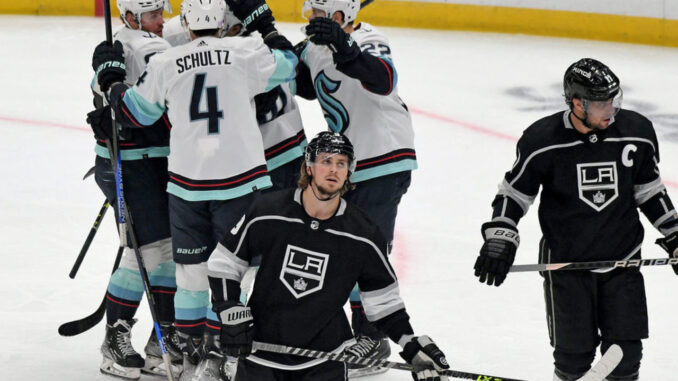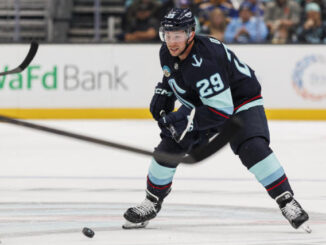
Don’t look now, but the Seattle Kraken are on fire. The second-year club rode a 10-1-1 record in November (with the second-highest points percentage over that time) to now sit second in the Pacific Division and fifth in the league overall. It’s a stark contrast from their record at the end of November during their inaugural season when they were 8-13-1 and locked into last place in the Pacific.
The Kraken’s hot November can be chalked up to a number of factors, most of which revolve around the team’s beefed-up attacking arsenal. They’re better equipped to drive play in the right direction, as well as finish the chances they generate. Beyond that, the Kraken have maintained their strong defensive identity from last season and gotten competent goaltending to boot.
With those points in mind, let’s dive into the numbers powering the Kraken’s play under the hood over the past month.
Kraken Ranked Second-Overall in Team Offense
The most significant driver of the Kraken’s successful November run was their offense. Over 12 games, Seattle scored goals at the second-highest rate in the NHL (4.25 goals per game), lifting their season-long pace to 3.82 goals per game. That clip currently ranks third in the league and represents an increase of 1.22 goals per game over their pace last year (2.6 per game), which tied them for 28th with the Chicago Blackhawks.
The star of the month was undoubtedly free-agent signing Andre Burakovsky, as the 27-year-old winger tallied 15 points in 12 games (six goals and nine assists). He led the Kraken in shots (34) in November and averaged the third-highest ice time per night among the team’s forwards. Jordan Eberle and Matty Beniers both played at a point-per-game pace or higher, while Justin Schultz (11 points in 12 games) and Vince Dunn (seven in 12) both provided offense from the blue line.
Related: 3 Factors Behind The Seattle Kraken’s Strong Start
After only having three 20-goal scorers last season, the Kraken currently boast six skaters on track to hit that mark. Whether it’s better finishing luck (they lead the NHL in 5v5 shooting percentage) or just the natural byproduct of injecting more skill into the lineup, the Kraken offense is humming.
Even-Strength Play Shows Kraken are For Real
While finishing chances is a skill and can sometimes be affected by luck, whether a team regularly controls play is a better barometer of how well the team is faring on the ice. Luckily for the Kraken, their on-ice results at 5v5 point to a squad consistently on the positive side of the ledger when it comes to shots and scoring chances.
According to Natural Stat Trick, the Kraken are taking 52.9% of all shots on goal (seventh in the NHL), account for 50.5% of high-danger chances (16th), and own a 52.2% share of expected goals (11th).
Although their finishing has been a defining feature of the campaign, their shot and chance generation has forced them to rely more on their defensive structure to grind out results. The Kraken only rank 17th in shots for per 60 minutes and dwell in the bottom-third of the league in terms of scoring chances and high-danger opportunities per 60.
Related: The Seattle Kraken Are Mishandling Shane Wright
In contrast, the Kraken’s defensive results are pristine and give them some leeway when it comes to their occasionally feeble attack. They allow the third-lowest rate of shots against per 60 and the fourth-lowest rate of high-danger chances against per 60. The Kraken might see their finishing luck dry up at some point, but their defensive play and control of possession should help them keep the worst at bay. Those numbers did see a dip in November, but their season-long results look much more favorable.
Kraken Penalty Kill the Lone Sore Spot in November
Not to continue turning to the negative, but the Kraken’s poor performance on the penalty kill was the criticism that could threaten to derail the rest of the season.
The Kraken were fairly disciplined in staying out of the box (they ranked 20th in average shorthanded ice time in November) but struggled with their kill efficiency. Their 70.3% success rate was the 25th-ranked mark over the past month and comes in at 68.6% on the season, 30th in the entire league.
While raw penalty kill percentage (PK%) is often affected by goaltending – both good and bad – the Kraken’s underlying numbers aren’t the most indicative of future success. Here are their metrics on the penalty kill for November, according to Natural Stat Trick:
| Statistic (Per-60-Minutes) | Seattle Kraken | NHL Rank |
| Shots Allowed | 59.4 | 20th |
| Scoring Chances Allowed | 63.4 | 20th |
| Expected Goals Against | 8.9 | 23rd |
| High-Danger Chances Against | 30.2 | 27th |
The number that pops out is their rate of high-danger chances conceded, with their pace for November sitting just outside the bottom five for the entire league. Teams can live with facing a high volume of shots if they are of low quality, but not being able to prevent opponents from getting into good scoring areas – such as in the slot – is a death knell for their overall defensive metrics.
Their shorthanded goaltending also did them no favors last month (they allowed the seventh-highest rate of goals against), suggesting that all of the aspects of their penalty-kill strategy needs an overhaul. After all, offense can only get you so far.
Journeyman Jones Takes Control of Kraken Crease
Apart from their suddenly dangerous attack, much of the Kraken’s early success can be attributed to finally getting competent goaltending. Their netminders had a season to forget in 2021-22 in combining for the league’s worst team save percentage (SV%), with prized free-agent signing Philipp Grubauer, the lead culprit for their poor results.
Martin Jones (signed as a free agent this summer) played in 10 of the Kraken’s 12 games in November and can claim some of the responsibility for their strong start. He only posted a .901 SV% over the past month but still saved 1.79 goals above expected (GSAx), which means he outperformed his workload.
Related: NHL Expansion History Positive Sign For Seattle Kraken’s Second Season
Grubauer was sidelined with injury for most of November but has yet to regain his Vezina Trophy form from 2019-20. Through his first five games, the German netminder has conceded 3.47 goals more than expected, and his .870 SV% ranks 65th out of 67 goalies to have played at least five games so far this season.
As I pointed out, the Kraken’s strong underlying defensive metrics give their goalies a sturdy platform off of which to work, but they’ve yet to settle on a long-term option. Jones looked good in November, but it’ll be interesting to see if he can maintain his surprising form.
Is November a Sign of Things to Come for the Kraken?
Ahead of the 2022-23 season, the Kraken’s offense and goaltending were under the most scrutiny. Through the first two months of the season and particularly during November’s hot streak, those two issues look to be temporarily resolved. The team’s high finishing rate may be a tad unsustainable, but they are an above-average chance generation group and should maintain enough of their defensive stability to make up the difference in any dropping percentages.
Goaltending is easily the biggest wildcard, and both Grubauer nor Jones don’t have the most outstanding track record in recent seasons. It’s been positive through the first quarter of the season, but that’s an extremely small sample size, all things considered, and I wouldn’t be surprised to see them collectively revert back to pre-2022 levels. For now, enjoy the ride, Kraken fans; you deserve a winner.
Data courtesy of Evolving Hockey, MoneyPuck, Natural Stat Trick, and the NHL. Statistics are accurate as of November 30th.




